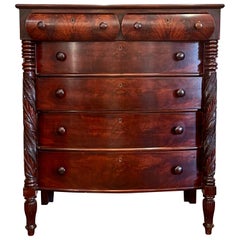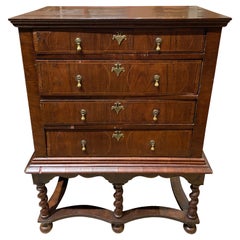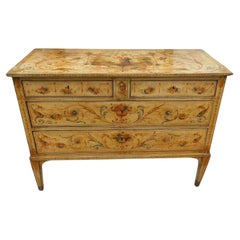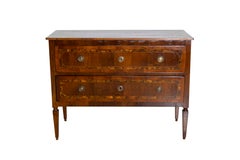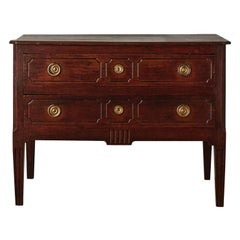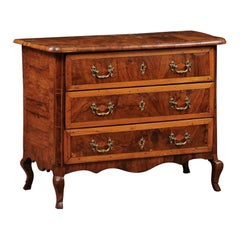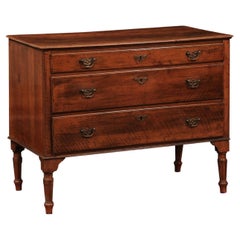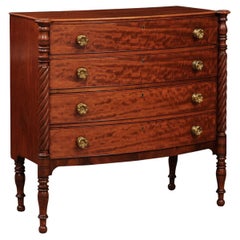Antique Chest With Legs
19th Century American Antique Chest With Legs
Mahogany
18th Century English Antique Chest With Legs
Brass
1780s Italian Neoclassical Antique Chest With Legs
Brass
18th Century Italian Antique Chest With Legs
Walnut, Burl
18th Century French Antique Chest With Legs
Cherry
18th Century Italian Antique Chest With Legs
Wood
Late 17th Century French Louis XVI Antique Chest With Legs
Walnut
18th Century French Antique Chest With Legs
Walnut
19th Century American Antique Chest With Legs
Wood
18th Century Italian Antique Chest With Legs
Walnut
Early 1800s German Empire Antique Chest With Legs
Brass
Late 18th Century French Louis XV Antique Chest With Legs
Bronze
Mid-18th Century French Louis XV Antique Chest With Legs
Wood
Mid-18th Century French Louis XV Antique Chest With Legs
Walnut
1730s English George II Antique Chest With Legs
Walnut
Early 19th Century Unknown Jacobean Antique Chest With Legs
Silver Leaf
Mid-19th Century Swedish Gustavian Antique Chest With Legs
Brass
1830s German Biedermeier Antique Chest With Legs
Cherry
Late 18th Century Italian Neoclassical Antique Chest With Legs
Marble, Bronze
Early 20th Century English Antique Chest With Legs
Silver Plate
Early 20th Century Korean Antique Chest With Legs
Brass
19th Century Chinese Antique Chest With Legs
Wood
Early 20th Century Korean Other Antique Chest With Legs
Brass
17th Century Spanish Baroque Antique Chest With Legs
Walnut
1880s English Antique Chest With Legs
Glass, Mahogany
Early 1900s Indian Antique Chest With Legs
Bronze
18th Century and Earlier English Antique Chest With Legs
Early 19th Century German Biedermeier Antique Chest With Legs
Walnut
19th Century American Antique Chest With Legs
Wood
Early 20th Century Swedish Gustavian Antique Chest With Legs
Brass
Mid-19th Century American Primitive Antique Chest With Legs
Wood
1770s American Queen Anne Antique Chest With Legs
Maple, Pine
Early 20th Century European Antique Chest With Legs
19th Century French Antique Chest With Legs
Brass
Early 20th Century English Antique Chest With Legs
Walnut
Early 1900s French French Provincial Antique Chest With Legs
Brass
19th Century English Antique Chest With Legs
Wood
Late 19th Century French Antique Chest With Legs
Walnut
19th Century English Antique Chest With Legs
Oak
1780s English George III Antique Chest With Legs
Brass
Mid-18th Century English Georgian Antique Chest With Legs
Wood, Oak
Early 19th Century French Antique Chest With Legs
Early 20th Century Edwardian Antique Chest With Legs
Walnut, Cedar
Early 20th Century French Antique Chest With Legs
Brass
Late 18th Century French Louis XVI Antique Chest With Legs
Walnut
Early 19th Century Italian Neoclassical Antique Chest With Legs
Walnut
Early 19th Century Italian Neoclassical Antique Chest With Legs
Wood
19th Century French Antique Chest With Legs
Brass
Early 19th Century French Antique Chest With Legs
Walnut
Late 19th Century French Directoire Antique Chest With Legs
Oak, Walnut
Mid-19th Century French Directoire Antique Chest With Legs
Walnut
Late 19th Century Danish Rococo Antique Chest With Legs
Wood
Early 19th Century French Empire Antique Chest With Legs
Cherry
18th Century French Louis XV Antique Chest With Legs
Walnut
18th Century French Regency Antique Chest With Legs
Elm
Mid-19th Century French Louis XV Antique Chest With Legs
Brass
Late 19th Century Italian Louis XV Antique Chest With Legs
Brass
Early 20th Century French Louis XVI Antique Chest With Legs
Brass
19th Century Austrian Antique Chest With Legs
Early 19th Century Italian Empire Antique Chest With Legs
Brass
- 1
Antique Chest With Legs For Sale on 1stDibs
How Much are Antique Chest With Legs?
Finding the Right Commodes-chests-of-drawers for You
Shopping for a commode or a chest of drawers?
Commode is the French term for a low chest of drawers, but it is also sometimes used to denote any case piece with a particularly intricate design. The commode dates to circa 1700 France, where it was used as an alternative to a taller cabinet piece so as to not obscure paneled, mirrored or tapestried walls. Coffers, or chests, which were large wooden boxes with hinged lids and sometimes stood on ball feet, preceded chests of drawers, a fashionable cabinet furnishing that garnered acclaim for its obvious storage potential and versatility. The term commode was also used to refer to a piece of bedroom furniture — a washstand or nightstand that contained a chamber pot.
As time passed, French and British furniture makers led the way in the production of chests of drawers, and features like the integration of bronze and ornamental pulls became commonplace. Antique French commodes in the Louis XV style were sometimes crafted in mahogany or walnut, while an Italian marble top added a sophisticated decorative flourish. This specific type of case piece grew in popularity in the years that followed.
So, what makes a chest of drawers different from a common dresser? Dressers are short, and chests of drawers are overall taller pieces of furniture that typically do not have room on the top for a mirror as most dressers do. Tallboys and highboys are variations of the dresser form. Some chests of drawers have one column of four to six long drawers or three long drawers in their bottom section that are topped by a cluster of small side-by-side drawers on the top. To further complicate things, we sometimes refer to particularly short chests of drawers as nightstands.
Even though chests of drawers are commonly thought of as bedroom furniture to store clothing, these are adaptable pieces. A chest of drawers can house important documents — think of your walnut Art Deco commode as an upgrade to your filing cabinet. Nestle your chest near your home’s front door to store coats and other outerwear, while the top can be a place to drop your handbag. Add some flair to your kitchen, where this lovable case piece can hold pots, pans and even cookbooks.
When shopping for the right chest of drawers for your home, there are a few key things to consider: What will you be storing in it? How big a chest will you need?
Speaking of size, don’t dream too big. If your space is on the smaller side, a more streamlined vintage mid-century modern chest of drawers, perhaps one designed by Paul McCobb or T.H. Robsjohn-Gibbings, may best suit your needs.
At 1stDibs, we make it easy to add style and storage to your home. Browse our collection of antique and vintage commodes and chests of drawers today.
- 1stDibs ExpertSeptember 9, 2024To tell if a chest is antique, first examine its materials and details carefully. An antique chest is one produced 100 years ago or more. This generally predates the use of engineered wood, particleboard, plastics and other synthetic materials. As a result, an antique chest usually features solid wood construction.
In addition, antique chests are likely to be handmade, so you should be able to spot subtle signs that indicate this, such as tool marks and small irregularities in any carvings. If a piece looks flawless and regular, it is unlikely to be antique. Locating a maker's mark and then researching when the manufacturer was active can also help you date your chest. Alternatively, you can use the services of a certified appraiser or knowledgeable antique dealer to learn more about your chest.
On 1stDibs, shop a large selection of antique chests. - 1stDibs ExpertNovember 4, 2024To identify an antique chest of drawers, look inside and beneath drawers and on the back and bottom for any type of maker's marking. Researching these marks using trusted online resources may allow you to determine who produced your chest and roughly date your piece. If your chest is at least 100 years old, it is an antique. Should you be unable to locate the maker's marks, look at the hardware. Rose head nails, one-piece cast brass pommels on the drawer handles and circular rather than hexagonal bolts may all indicate that a piece is an antique. Keep in mind that hardware may have been replaced at some point and that there are many reproductions of antique furnishings. As a result, you may wish to have a certified appraiser or experienced antique dealer complete the identification process if you're unable to identify your chest via the maker's markings. Find a range of antique chests of drawers on 1stDibs.
Read More
The Ultimate Guide to Types of Tables for the Home
Whether you’re just moving in or ready to give your home a makeover, our guide will give you pointers on tables that are fitting for every room, nook and hallway.
What Exactly Is a Secretary Desk, and What Is It Used For?
The furniture equivalent of a Swiss Army knife, it's the multifunctional piece you didn't know you needed.
This Shelving System with Oxidized Brass Tubes Is Retro and Futuristic at Once
Italian studio DimoreMilano mustered great ingenuity when crafting these sculptural shelves, which are built without any screws.
28 Cheerful Home Bars, Where Everybody (Literally) Knows Your Name
Simple or sophisticated, equipped with console, cart or custom cabinetry, these stylish bar areas deserve a toast.
Ask an Interior Designer: Work-from-Home Edition
Leaping into a design project, whether it's refreshing the bedroom or redoing the whole house, can be overwhelming. Luckily, we know more than a few interior designers. You asked questions on Instagram, and now they're answering.
Collected and Eclectic, ‘Wunderkammern’ Are Back in a Big Way
Introduced nearly 500 years ago, curiosity cabinets are finding new fans among today's collectors and designers.
Meet the Incredible Woman Transforming Fallen Trees into Sleek Furniture
In the hands of New York Heartwoods cofounder Megan Offner, unwanted local trees become works of design art.
These New York Architects Love a Complicated Project
From Brooklyn townhouses to Maine campgrounds, Trattie Davies and Jonathan Toews relish a challenge, like transforming a former warehouse space into the new 1stdibs Gallery.
